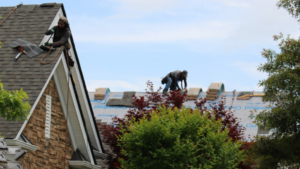
Unless you are a roofing expert, chances are that you’ve never given much thought to the structural design features of your asphalt shingles. It’s also unlikely you’ve ever considered the purpose of those tiny little sand-like granules on the shingles, and how they might help your roofing shingles to protect your home. The truth is, that asphalt shingle granule loss can lead to roof damage that, left untreated, can result in costly roof repairs or even a total roof replacement.
Artisan Quality Roofing has everything you need to know about the loss of shingle granules and how asphalt shingle granule loss can affect the integrity of your roof and home. Knowing what to look for on your roof shingles can help maintain your roof over time and avoid the need for a replacement roof anytime in the near future.
What Are Shingle Granules?
If you look closely at 3-tab and architectural shingles, you will notice the sand-like texture of crushed stone granules on the outer layer of the shingle- these are called shingle granules.
Shingle granules add to the aesthetic appeal of the roof’s design. The color of your roof is thanks to those little granules that are made up of tiny pieces of fiberglass and stone. While they are credited with keeping the color of your roof looking nice, shingle granules also contribute to protecting your roof from the elements.
The function of granules on an asphalt shingle roof
- Protection from UV rays: The ceramic elements that make up the shingle granules are UV-resistant, working like a sunscreen to the rest of the shingle materials underneath them. It’s due to the shingle granules that your whole roof is protected from sun exposure.
- Heat reduction: Since shingle granules are reflective, they help to direct sunlight away from the roof, helping to keep your roof cooler on hot days.
- Fire resistance: The granules on your shingles are resistant to fire, making it a challenge for exterior fires to penetrate your roof and compromise your home.
- Directs water flow: In general, shingles help to shed water away from the roof, but it’s thanks to the granules on asphalt shingles that when water hits the roof, the water is drained off and away from the shingles.
- Stop the growth of algae: Algae growth occurs in particularly warm climates, and when it is able to grow and accumulate on aging shingles, the algae can attract and retain moisture. This makes the shingles more easily vulnerable to rot and further roof damage. Thanks to the copper elements in some asphalt shingle granules, the shingles resist algae growth.
- Ease of Installation: Shingles with granule materials make the installation of a shingle roof easier for contractors because the granules keep the shingles from sticking together. Also, the shingle granules offer better foot traction, allowing a roofing contractor to move and work more easily and quickly, making installation efficient and fast.
- Curb appeal: Granules provide a speckled, almost sparkly characteristic and are available in a huge variety of color options. When a roof shingle has a granule protective coating, the color is retained for longer, leading to the ultimate curb appeal to the aesthetics of your roof.
What Is Granule Loss on Asphalt Shingles?
Shingles are expected to shed granules over time, but slowly. When your roof’s shingles are continuously exposed to extreme weather, storm damage, fallen debris, and other outdoor elements, the roof ages, and the shingles deteriorate, shedding a few granules here and there. However, loose granules and significant granule loss can lead to the unnecessary deterioration of your roof. This premature granule loss will damage shingles, lead to the potential of costly leaks, or even result in a roof replacement.
A lot of things will contribute to granule loss- even simple installation will shed some of the little particles off of the surface of the shingle. It’s completely normal to notice, after heavy rainfall for example, that your shingles had some granule loss that collects in the gutters. It’s also common for normal wear and tears throughout the shingle’s lifespan to result in more granules lost over time.
Is Granular Loss Bad for My Roof?
Despite normal aging and elemental damage over the course of time being completely normal for granule loss, there are instances when too much granule loss can lead to the fast and unexpected deterioration of your roofing materials. In these cases, the loss of mineral granules on your shingles is not good for your roof.
Excessive granule loss is usually due to human-created events rather than the normal effects of Mother Nature. This kind of extreme granule loss is preventable, particularly if you know what to look for when assessing your granule shingles, the preventative measures you can take, and if you schedule regular roof maintenance services on your home.
Common Causes of Asphalt Shingle Granule Loss
Knowing what causes asphalt shingle roof granule loss can help keep your roof’s shingles in good shape, ultimately getting longevity out of the lifespan of the entire roof. Whether you are looking to protect your new roof or you’ve had the same roof for years, paying attention to the common causes of shingle granule loss through regularly scheduled roof inspections will help you avoid shingle damage.
Let’s explore the common reasons that your asphalt shingle roof might lose granules.
Improper Installation
If the original roofing contractors who installed your roof tried to cut corners in spending or were not properly trained to install the roof’s shingles, their errors could lead to an increase in missing granules over time. Failing to meet the installation standards set forth by roofing manufacturers is the fault of an inexperienced roofing contractor.
New Roofing
When replacing an older roof with a new one, your roofing contractor will inevitably be walking on the new roof replacement during installation. In addition to foot traffic, your roof structure will be met with handling, cutting, and nailing. No matter how experienced your roofing company is, it is expected that new roofs will experience some granule loss during installation.
Foot Traffic
It’s important to keep your roof and gutters clean from debris and buildup as well as have annual roof maintenance performed. However, during these events, your roof will experience a lot of foot traffic, which can result in lost granules. It is a feature of the normal life of a roof to experience some stepping on the shingles from time to time as needed, just be sure not to excessively walk on and disrupt the shingles on your roof.
Fallen Debris
When tree limbs, rocks, or debris fall on your roof, it can scrape the roofing shingles and strip granules off the surface of them. By pruning large trees or tall shrubs surrounding your home, you can alleviate some of the risks of fiery debris damaging your asphalt shingles.
Clogged Gutters
Scattered shingle granules will collect in your gutters from time to time, but if you do not regularly clear out your dirty gutters, those materials that are clogging your gutters can be blown by heavy winds or other severe weather, causing the accumulated dirt, debris, sticks, and other materials to further damage your shingles and lead to even more granule loss.
Storm Damage
Heavy rain, snow, ice, heavy winds, and a hail storm can lead to damaging your roof- but when you have an asphalt shingle roof, one of the consequences of a severe storm will often be the loss of granules from your shingles. After a heavy storm, it’s always a good idea to schedule a roof inspection with local roofing professionals. During a roof inspection, your contractor will assess any damage and recommend repairs that can lead to the longevity of your roof.
Pressure Washing
There are plenty of successful methods for cleaning your roof, but pressure washing your roof shingles is not one of them. Power washing asphalt shingle roofs result in mineral granules being lost and is one of the ways to ensure your home is going to need roof repairs in the near future. A pressure washer will produce far too much force for the shingles to stand up to, causing unnecessary damage that will need roof repair.
The Age of the Roof
Most asphalt shingle roofs have a lifespan of between 15 to 25 years. After years worth of exposure to outdoor elements, older roofs will experience more and more loss of granules over the course of time.
Signs Your Shingle Granules Need Repairs or Replacement
You aren’t a roofing professional, so how are you supposed to know if your shingle granule loss is normal or leaning more toward the serious side of granular loss that will result in a roof repair or replacement?
Here are the biggest tell-tale signs that your asphalt shingle roof granule loss is affecting the integrity of your roof’s performance:
- Bald shingles, meaning they’ve lost all visible signs of granule existence.
- Shingles are peeling, curling, buckling, or sagging.
- Rusted, corroded, damaged metal flashing joints and seals.
- Leaks inside the attic or ceiling.
Contact Artisan Quality Roofing for Roof Replacement and Repair!
Do you see signs of granule loss on your asphalt shingle roof? As soon as you see signs of roof damage, it’s important to find a professional roofing contractor you can trust!
At Artisan Quality Roofing all of our roofers are licensed, knowledgeable, and equipped with the skills needed to repair or replace your asphalt granules. Our NC roof repairs company has served the local communities of Raleigh, Apex, Chapel Hill, Durham, and the surrounding areas for over ten years.
Call us today at 919-906-3791 to request a free estimate on your roof repair and maintenance.



